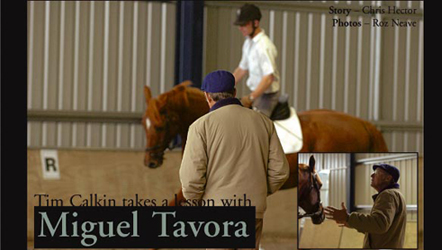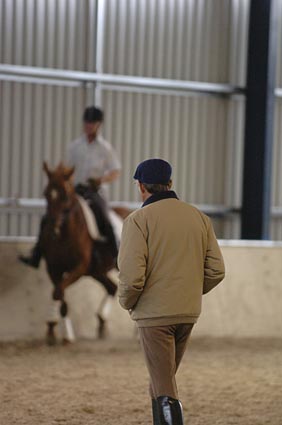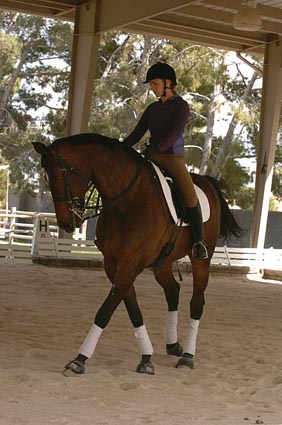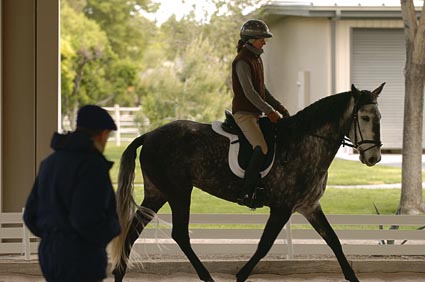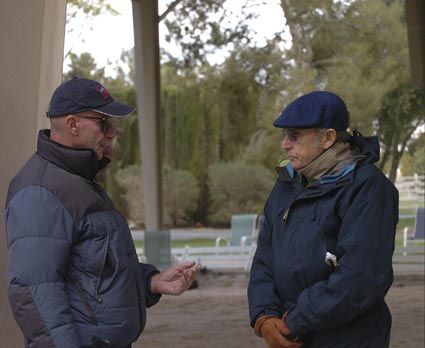There is always something quietly calming about watching Miguel Tavora teach, and it is not entirely surprising since Miguel comes from a Portuguese school of horsemanship that valued elegance and lightness, learning and grace.
Miguel – or to give him his correct title, Major Tavora – was a student and later an instructor at the Military Equestrian School at Maffra, and also worked with the late, great Nuno Oliveira – a teacher who stressed the close relationship between equitation and art.
It is a background that could easily see Miguel lumbered with those Oliveira followers who consider themselves way too artistic to compete, but again this would not be fair.
Miguel has trained a number of very fine FEI competition horses, and his present teaching philosophy is much influenced by modern German training principles with a distinctive Iberian flair.
At one stage he asks his pupil to make an ‘uberstreichen’ and jokes ‘see how good my German is these days…’
Why Uberstreichen not descente des mains, I ask?
As usual, Miguel’s reply is that of a scholar and a trainer –
“Descente des mains is more for collection, uberstreichen is more to get the horse to encourage self carriage. With descente des mains, we do just that, lower the hands a little. In both cases it is to break the contact, but uberstreichen is more useful when we are warming up or riding a green horse. Descente des mains is something we do later, and with a more advanced horse. With uberstreichen we break the contact and the horse stays in same frame and the same rhythm.”
The exercises are a brilliant mix of French and German, but always – and surely this is the hallmark of any good trainer of whatever nationality – on getting the horse looser, more elastically in contact with the rider.
Tim Calkin is riding a 7/8ths Thoroughbred mare by Woodmount Magic out of a Balmoral Boy mare with just a touch of Clydie.
Miguel is getting Tim to ride little circles in trot, giving away the inside hand, getting the horse to give its body to the rider.
“Keep the inside leg more forward, if the horse starts drifting in, ride the inside diagonal. If you feel the inside hind leg not coming forward change to the inside diagonal. On that inside diagonal, get the horse round and down, touch the neck with your inside hand. Now come taller… and walk.”
“Now canter around me, remember your hands are an extension of your back. Touch the neck, that is very important – open the door and you have a very good surprise!”
“Collect, legs back, taller, walk – that is a beautiful warmup.”
It’s time for Miguel to launch into one of his pet hates – saddles with big leg rolls.
“These saddles might be alright for riders with really long legs, but some people do not have such long legs, and these rolls throw them forward on the fork – and to stop this they have to brace their back! I think the saddle maker is the instructor now.”
“When I was learning showjumping, the saddles had pads everywhere, the rider’s leg was locked in and immobilised. Then the showjumping riders realised that this was stupid, you need to be free to move in the saddle. The showjumpers got rid of those saddles – and now it is the dressage riders who want to go back to the seventeenth century. To ride well you have to have your legs in the right place because your seat is in the right place – when your seat is in the right place, then the back is in the right place, and the legs are in the right place.”
I ask Miguel about his characteristic little circle round the inside leg, where does this exercise come from?
“It is an adaptation of an old exercise of the horse around one pillar, then de la Guérinière got rid of the pillars.”
You can see the immediate effect of the exercise:
“Let go a little, lower the neck, more bend. Immediately you got a little more bend, she let go in the back.”
Time to move on to some more advanced work, and once again, Miguel’s sense of history is well in place:
“The shoulder in is very nice – la Guérinière would be proud of you. She is a bit open in the poll, half halt with your fingers and flex.”
There is a mood of elegant joy that goes with riding like this, quietly building from one step to the other, quietly unfolding the horse’s potential, we are lucky in Australia that Miguel decided to make us his home.
TIM CALKIN ON HIS LESSON:
What were you setting out to do in that lesson?
“With this mare, because it is my wife’s horse and it has been out of work for quite a while, the aim was just to get her nice and soft and deep and round again. Because of her shape – her croup is very flat – she is quite a difficult mare to ride. Because Miguel works the horse so softly and so nicely – you can see she is a little inclined to get toey – by working her that way she is more consistent, she is more in self carriage, she is more flexible, and we end up with a better result.”
Tim Calkin grew up and went to school in Australia and went back to the UK when he was 15.
“I got into horses over there. I did my all my BHS training, and came back to Australia in 1985. I was doing six months here and six months in England, and eventually in 1988 emigrated here full time, and I’ve been here ever since.”
“I teach, mainly private lessons, I don’t do too many group lessons. A few riding clubs. We’ve got 56 acres over in Healesville and we are just in the process of putting in an Indoor school. I’ve got a Thoroughbred stallion, Balmoral Kinsman that I stand. He is nearly Advanced now. We don’t do it in a big way because the Thoroughbred is not really fashionable, but I like riding Thoroughbreds, my next young horse is a Thoroughbred. We are basically a teaching operation but we like to hope we are more exclusive than the average riding school.”
“I started having lessons with Miguel in 1997, and he teaches along the lines I prefer, allowing the horse to be very soft and relaxed. So often nowadays you see horses that are tense, not going forward, jammed up. Miguel is just totally the opposite. He uses a lot of lateral work to make the horse soft and it just appeals to me. It doesn’t matter how many horses I work with, what type of horse I work with, if I follow his lines I end up with a nice soft, relaxed horse – and we work all sorts of breeds.”
MIGUEL ON THE LESSON:
“I was trying to make the mare very strong, keeping her good movement. She has not been in very consistent work, and her back has disappeared completely. Because the mare is already at an Advanced degree of training, I was using some more Advanced exercises, but not asking too much collection because the mare’s back would not cope with it.”
“When she performs travers, she should be more collected but rather she was on the way to collection. I want to prevent any blockage through the back, because if she blocks the back then I am going to lose the swing. If I ask her to be very collected now, as it says in the rulebook, then I would spoil the exercises we were doing to improve the trot – just for the sake of the exercise, we would destroy the trot!”
“So instead I was letting her go in an attitude which is more horizontal than she should be in that exercise, but at the same time using that exercise to engage her more, and getting that engagement without too much pressure on the back, and developing swinging in the trot. You could see sometimes in the rising trot, sometimes in the collected trot, because the back was blocking a bit, she was starting to hover in the trot. This was because she’s got movement that is not passing through the back and I have to make her lower a bit more the neck, take the pressure off the back, and when she swings the correct way, I can bring her back to the collection.”
Tell me about the exercise when you have the rider on the ‘wrong’ – inside – diagonal in the trot?
“When you sit on a horse, all the time you have your weight on the saddle, you can never take your weight off the saddle, your feet are in the stirrups and the stirrups are connected to the saddle and the weight is still there. But when you rise to the trot, you shift the weight forward and backwards, and when you go up, because the stirrups are attached more in front, it tips your weight more forward. But in fact, when you are rising you are putting more pressure than when you are sitting because as you go up, you press down. When you rise to the trot with the outside diagonal – suppose you are going in trot on a circle left, and you rise with the outside diagonal, you rise when the outside diagonal – right front leg, left hind leg – is off the ground.”
“Because of the centrifugal force of the circle, your horse leans a bit on the left hind leg, then to release on the left hind leg, I rise to the trot on the outside diagonal in order not to put pressure on the inside hind leg. But if I find the horse a bit lazy with the inside hind leg, and it is not bending enough, and is not using the inside hind leg in the correct way, with the power that she should use, by rising to the trot on the inside diagonal – the wrong diagonal – I am putting pressure on the stirrups when I go up – when the inside hind leg is on the ground. Here we go again against the rules of the cause to the effect, because the cause is: when the horse goes on the right, bent to the right, it needs to tilt the ribcage to the left, then the abdominal muscles are not in the way, and the right hind leg can swing forward. If it doesn’t tilt to the left – this is what you see on green horses – then the horse is falling in on the circle because the rib cage is in the way, and the abdominal muscles are not allowing the inside hind leg to come under. We are going a bit against the rules because what I should do is make her tilt the rib cage to the left to make the hind leg work. I put pressure on the inside hind leg, and the horse, in order to do the correct job goes to the cause which is the ribcage, and tilts the ribcage to the left and allows the inside hind leg to step under. It is a little against the rules but it works very good.
If you are looking at a horse, and when he trots on one diagonal, he is a bit short and you don’t know if the horse is lame, or it is just bad training, a good technique is to rise to the trot on the other diagonal. If he becomes worse, you call the vet, or don’t buy the horse! If he becomes better, you know the horse was just being lazy, and you can buy it. Often you see a green horse trot with one diagonal shorter than the other, it looks funny. OK, rise with the trot on the right diagonal, it is putting pressure on the right hind leg, and he gets better – okay, that’s training, he becomes worse – oh oh something is wrong, I don’t touch him, and if I own him, I call the vet.”
So a month after we do our lesson with Miguel in Victoria, we are in Las Vegas for the World Cup – and guess who is doing a lesson down the road? Sure enough, another Miguel pupil, this time, Alex Duarte, one of Miguel’s Australian students, now living in America, riding the eight year old Holsteiner, Lennon, that Miguel found for her in the United States. Miguel’s clinic was held at an equestrian centre, just outside Las Vegas.
Above: This four year old Lusitano mare, was born in Brazil, and imported to the United States, before being sent (as part of a group of six) to Australia, for Miguel to break in and work for 12 months, before being returned to her owner, and rider, Marilyn Hite.
Above: And guess who decided that if there was a clinic just down the road, he wanted to be there? Jumping guru, George Morris is ALWAYS keen to learn, and enjoyed his time watching Miguel teach…

